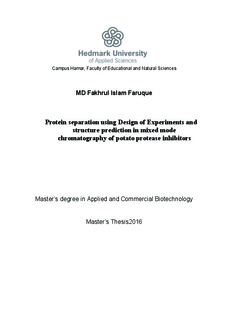Protein separation using Design of Experiments and structure prediction in mixed modechromatography of potato protease inhibitors.
Master thesis
Permanent lenke
http://hdl.handle.net/11250/2401168Utgivelsesdato
2016Metadata
Vis full innførselSammendrag
Mixed-mode chromatography is a chromatographic method in protein purification that
utilizes more than one form of interactions between the stationary phase and the solutes. As being
advantageous over other types of adsorption chromatography it has better salt-tolerant
adsorption, unique selectivity, and facile elution by charge repulsion.
Potato fruit juice (PFJ) is a by-product from industrial starch manufacture and contains
several proteins such as patatin, protease inhibitors and others. Several protease inhibitors
(Kunitz-type inhibitors, Potato protease inhibitors I and II, potato cysteine etc.) are ubiquitous and
they account for 1-10% of the total protein. Potato proteins, especially the protease inhibitors are
a potential resource of proteins for potential pharmaceutical and nutraceutical applications.
Recent advances in the isolation of major proteins from industrial potato fruit juice (PFJ) using
novel chromatographic resins are opening new possibilities to develop value-added proteins. The
aim of the work that has been presented in this thesis was to separate potato protease inhibitors
using mixed mode chromatography and try to understand the aspect of interactions between a
cationic mixed-mode (MMC) ligand and proteins via bioinformatics tools.
The protease inhibitor fraction was isolated from industrial PFJ by acidification and
removal of precipitated patatin, before being loaded onto Capto MMC HiTrap-columns (1 ml and
5 ml). The ÄKTA Pure chromatography platform (GE Healthcare) was used in all of the
experiments. The effects of pH and conductivity on the adsorption behavior of PIs from clarified
and acid treated PFJ (CAP) properties have been investigated. For protein elution pH-shift,
different salts (NaCl, NH4Cl) and mobile phase modifiers (arginine, guanidine, lysine) were used
to investigate the binding behavior of protease inhibitors such as hydrophobic interaction,
repulsion etc. Responses were measured as eluted peak area (EPA) and by use of a trypsin
inhibitor assay (TIA). The statistical methods used in experimental design were one-way and
multi linear regression analysis (Design of Experiments). To predict the protein structure and
surface characterization different bioinformatics servers (NCBI, PDB) and tools (BLAST,
Phyre2) were used.
Maximum binding capacity of protease inhibitors on Capto MMC occurs at CAP sample
pH 4.3 and column buffer pH at 5.5-6.0, and at conductivity ranges 10.0-11.5 mS/cm. The
molecular weight of adsorbed PIs was in the range 3-22 kDa. Results indicated that optimal
binding capacity for PIs on Capto Hi-Trap MMC happens at precipitation pH 4.3. The effects of
column pH, sample conductivity, sample load and their interaction were significant. Of the mobile modifiers, arginine acted to weaken electrostatic interactions by increasing
the dielectric constant; this would lead to a uniform decrease in retention. An increased
concentration (0.1M) of arginine showed that more recovery of aggregated protein especially
protease inhibitors II group and PCPI (20 kDa).
By predicting protein surface revealed that mixed mode resin could be recognizing
different hydrophobic surface features exposed on the protease inhibitors.
Last but not least, it has done to separate protease inhibitors by multimode
chromatography and different condition effects can understand to binding behaviors of protein
and further also suggested chemical interaction of these protease inhibitors should be studied.
Beskrivelse
Mastergradsoppgave i næringsrettet bioteknologi, Avdeling for lærerutdanning og naturvitenskap, Høgskolen i Hedmark, 2016. Master of applied and commercial biotechnology.
